Agaricus, AgaricAgarikonGhariqoon (Unani) Ku Bai Tie 苦白蹄; A Li Hong 阿里红 (TCM) |

|
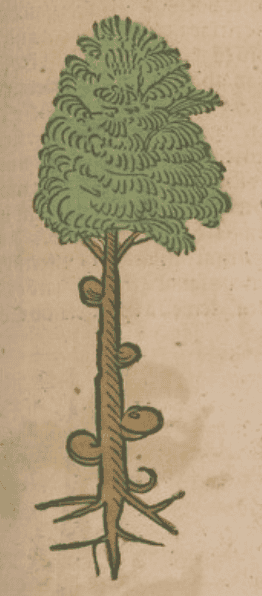 Ortus Sanitatis, Meydenbach, 1491
Ortus Sanitatis, Meydenbach, 1491
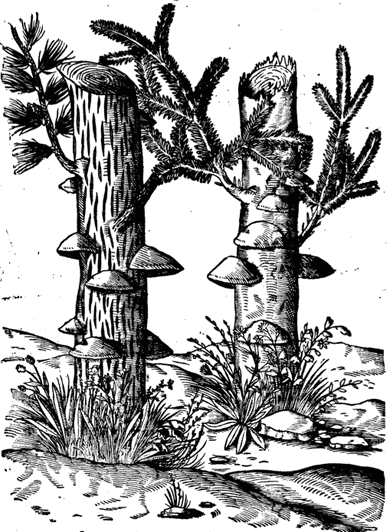
|
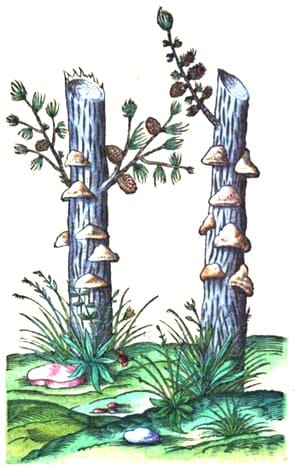
|
|
True ‘Larch Agaric’ New Kreuterbuch, Matthiolus, 1563 |
Agaric Kreutterbuch, Matthiolus, 1586 |
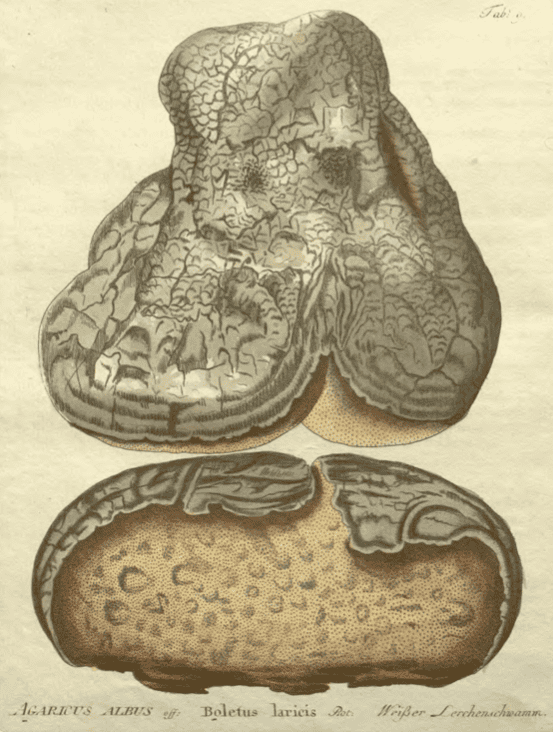 ‘Agaricus albus’
‘Agaricus albus’Icones Plantarum Medcio-oeconomico, Vietz, 1800
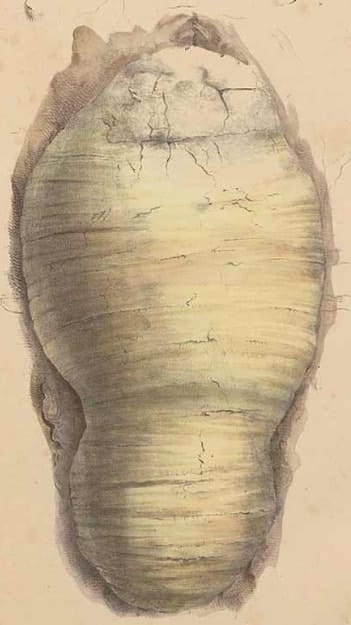
|
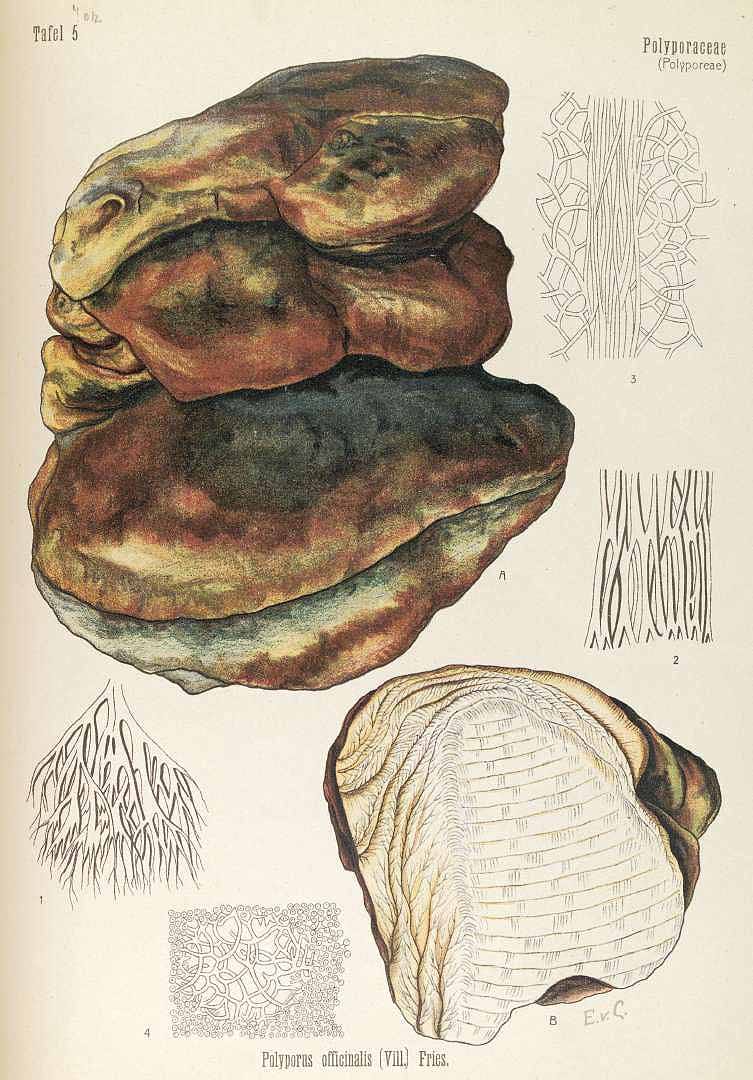
|
|
Polyporus officinalis (Nees von Esenbeck, T.F.L., Plantae officinales, vol. 2, 1828-1833) |
Polyporus officinalis Koehler, F.E., Medizinal Pflanzen, vol. 4 (1890) |
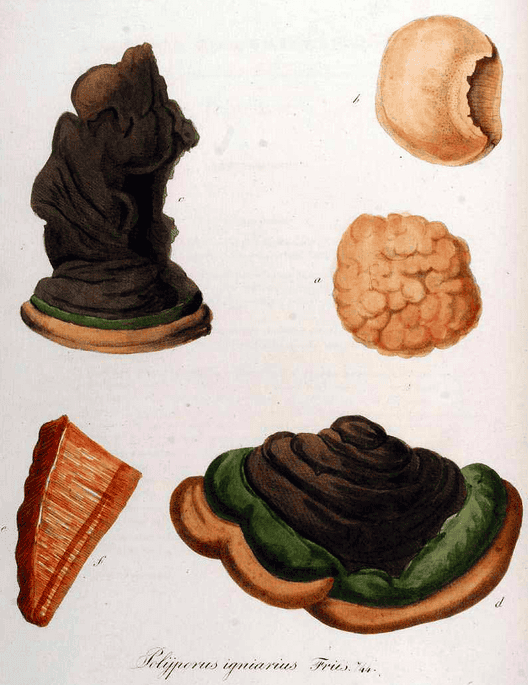
|
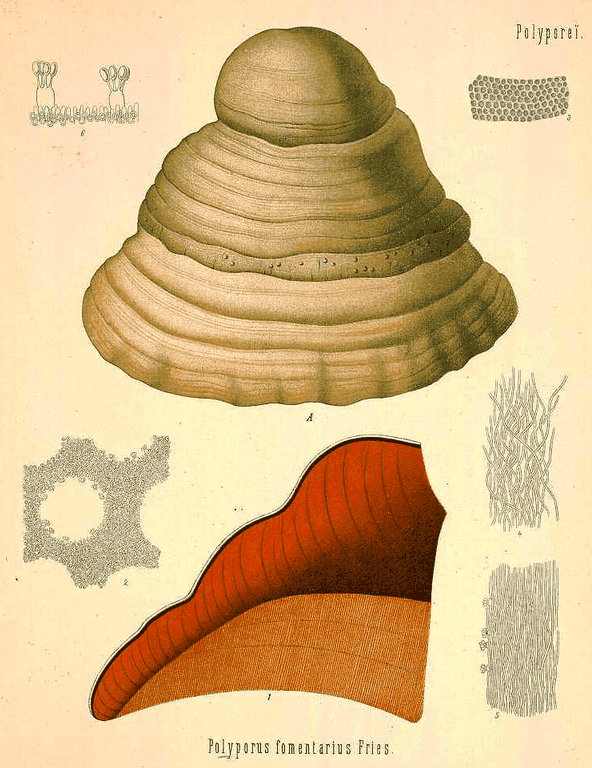
|
|
Polyporus ignarius, probably the lesser, ‘Male’ type (Kops et al., J., Flora Batava, 1849) |
Polyporus fomentarius, possibly another of the lesser types used (Koehler, F.E., Medizinal Pflanzen, 1890) |
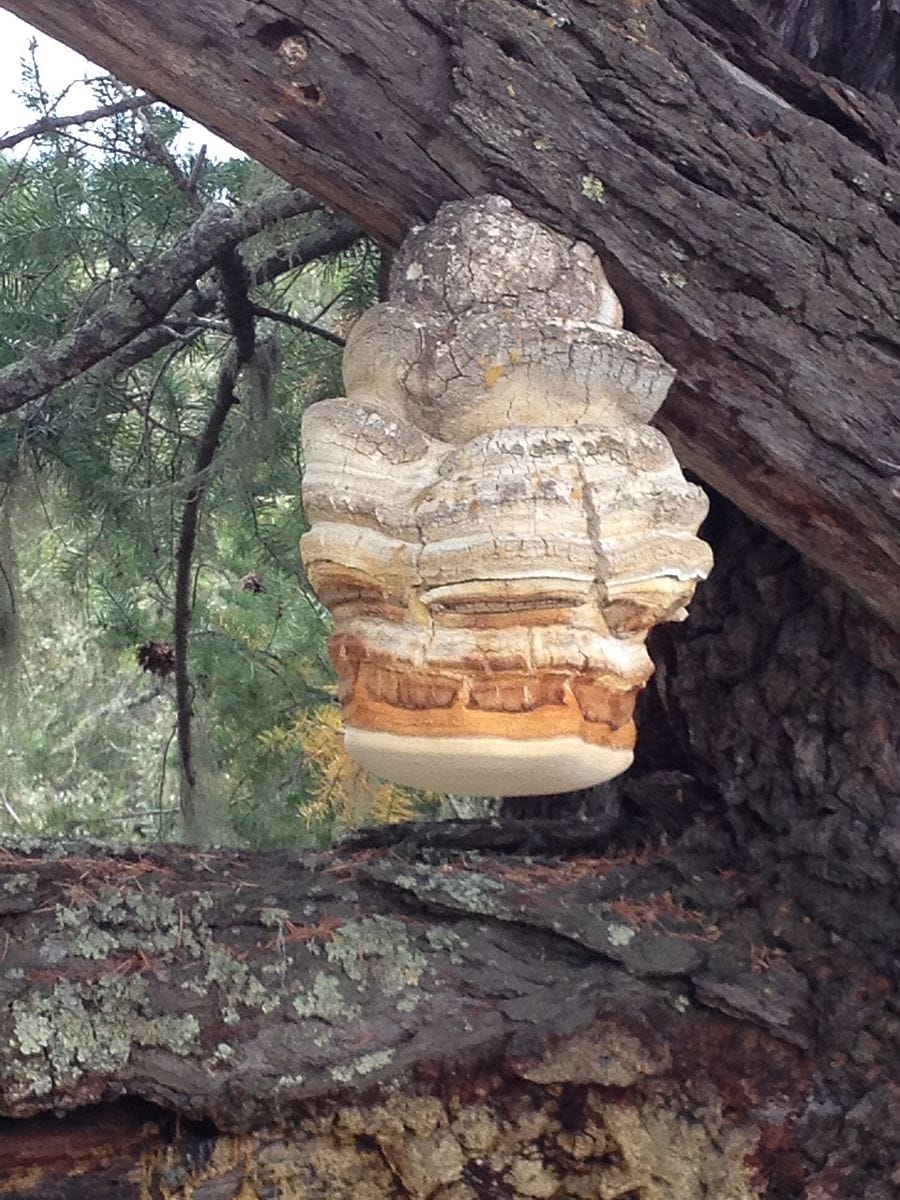 Laricifomes officinalis (as Fomitopsis officinalis)
Laricifomes officinalis (as Fomitopsis officinalis)(Photo by Steph Jarvis) (Wikimedia)
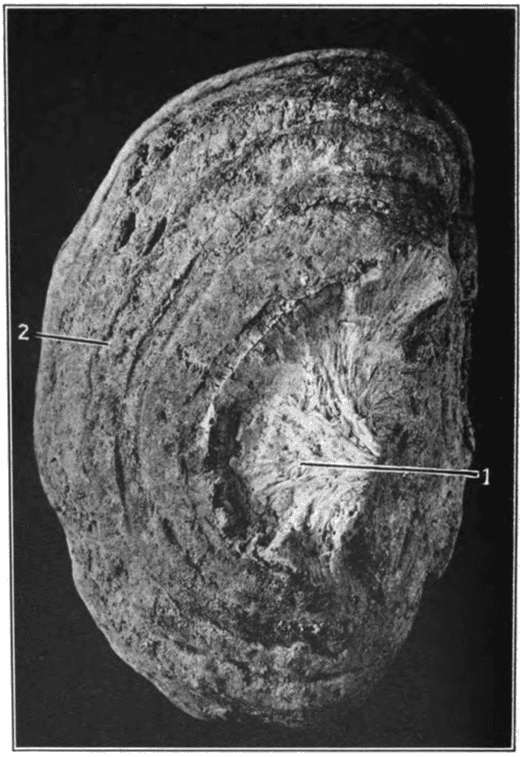 AGARICUS
AGARICUS1. White inner tissues. 2. Outer worthless part of the fungus.
This is interesting as it appears to be a Ganoderma or Phellius species on the
market in the early ‘s rather than the Traditional Laricifomes officinalis.
(Squibb’s Atlas of the Official Drugs, Mansfield, 1919)
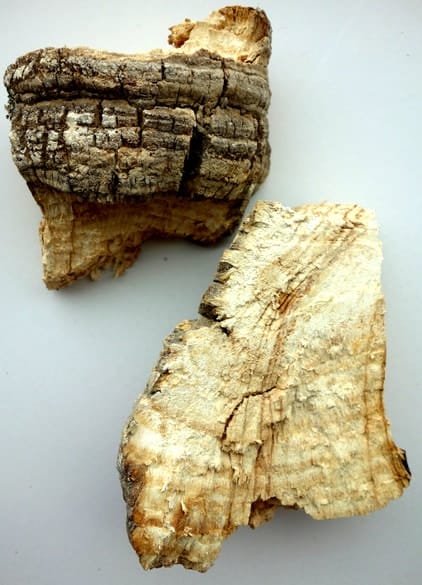
|
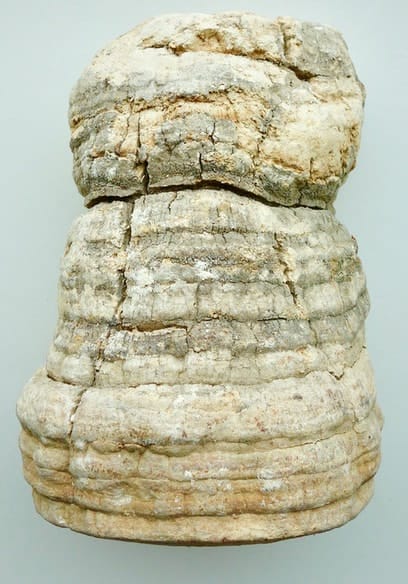
|
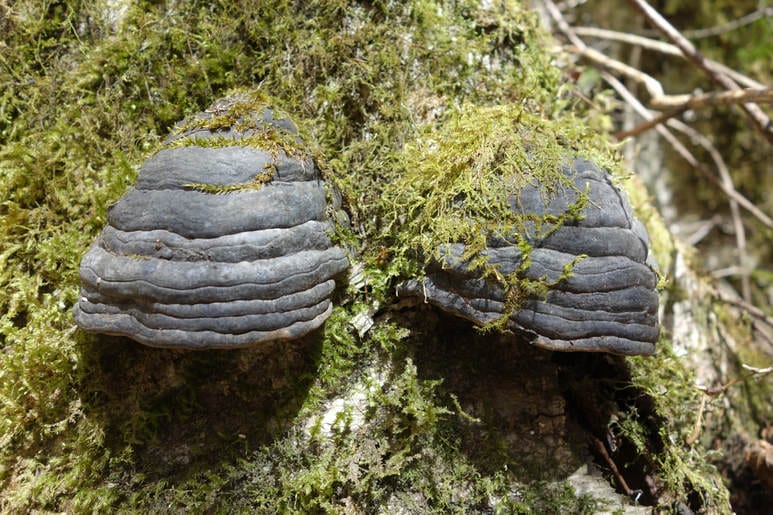 Fomes fomentarius, probably also used as a lesser type.
Fomes fomentarius, probably also used as a lesser type. Photo by Adam, 2018
BUY AGARIC POWDER

Botanical name:
Laricifomes officinalis (syn. Fomitopsis officinalis, Fomes officinalis, Fomes fuscatus, Polyporus officianle, Agaricum officinale, A. alba, Boletus agaricum, B. officinale, B. laricis, B. purgans, Cladomeris officinalis, Piptoporus officinalis, Ungulina officinalis)
Other species listed as sources of Agaric include Fomes fomentarius, Fomitopsis pinicola, Phellinus igniarius
Sources were said to be varied. Dioscorides differentiated between ‘Male’ and ‘Female’ types:
- Female: from the Larch, is white, light, tender, brittle, slightly bitter and pungent. (True Agaric)
- Male: from various trees, heavy, yellowish and woody (Ganoderma or Phellinus-type Agaric)
Dioscorides said the female contains horizontal gills, the male is massive and globular (no gills), clearly indicating different species. He also lists Oak roots and Cedar trees as being sources for the fungi. Matthiolus and others said the true Agaric was only found on Larch trees, while some said it was found on Oak, Fir and Pitch trees. This suggests at several species supplied the market.
Some modern Unani sources have listed 2 types:
- ‘White’ (Fomitopsis officinalis) (‘Female’)
- Fomes igniarius (syn. Phellinus igniarius). (‘Male’)
It should be noted that many of the Wood-growing bracket-type fungii have similar properties with a number proving to have immuno-stimulating polysacchardies, a main medicinal constituent in other medicinal fungii such as Ganoderma Ling Zhi and Poria Fu Ling. Various species of Phellinus and Ganoderma have shown similar constituents and effects.
Parts used:
Dried Fungus, preferably collected from Larch trees. The coarse outer coating is removed.
Temperature & Taste:
Mildly Warm (some said Cool), dry; sweet, then bitter
Incides, digests and opens
Classification:
2A APERIENT MEDICINES. 2C INCIDERS. 2F. PURIFYING. 2G. CLEANSING. 2K. RESOLVENT. 2O. ASTRINGENTS
3K. EXPECTORANT.
4d. PECTORAL. 4g. HEPATIC
Preparers and Purgers of Phlegm
Preparers and Purgers of Melancholy
Uses:
1. Dries Damp, Purges Phlegm:
-clears serous and viscous (thick) humors from the whole Body, especially the Mesentery, Head and Lungs
-Edema; obstructed or difficult Urine (West)
-Urinary Stones, Nephritis (TCM)
-Damp-type Jaundice; Diarrhea
-Damp or Watery swellings
-poor appetite and digestion from excess Damp; Stomach ache, Hyperacidity (West, TCM)
-Stomach ailments and Heartburn from Phlegm and Damp, the root can be chewed and swallowed by itself (Dioscorides)
2. Purges Melancholy,
-important medicine to purge Melancholy and Burnt Bile
-Melancholy, ‘Madness’, Insanity, Mental Illness including Schizophrenia
-bad complexion (Dioscorides)
-Fibroids, Tumors
3. Clears Phlegm, Stops Cough and Wheezing:
-Cough, Asthma, Shortness of Breath, Chronic Bronchitis (West, TCM)
-some recommended it for Consumption and Hemoptysis (Pemell, 1652)
-‘Ulcers of the Lungs’. (Avicenna)’
4. Clears Wind-Damp, Ease Pain:
-Arthritis, Rheumatism, Sciatica, arthritis of the Hip (with Oxymel)
-Rheumatoid Arthritis (TCM)
5. Clears Damp, Settles Wind, Stops Spasms:
-Epilepsy (with Oxymel)
-Vertigo, Dizziness
-Hysteria (Avicenna)
–Avicenna said it clears superfluous humors from the Nerves and Brain
6. Moves the Blood, Resolves Masses:
-Promotes Menstruation
–Contusions, Bruising (Pliny, taken with Honeyed Wine)
-Fibroids, Tumors, Cancer (esp. Esophageal, Lung, Nasopharynx, Liver, Stomach, Breast, Pancreas)
-strong inhibition of breast adenocarcinoma, colon adenocarcinoma, squamous cell carcinoma, fibrosarcoma
-proven to prolong survival or induce complete remission of Lung Cancer (SCLC, NSCLC)
7. Clears Wind-Heat, Resists Poison:
-one dram with diluted wine for Deadly Poisons (Dioscorides)
-Pharyngitis, Periodontitis (decoction as a gargle, TCM)
-Viper bites (Dioscorides); Venomous Snake Bite (TCM); Insect Bites (Avicenna)
-given beforehand for the Chills associated with Fever, and for Chronic Fever (Dioscorides, Avicenna)
8. Externally:
-Toothache, apply Clove oil of Agaric and apply topically (Pemell, 1652)
-hemorrhoids, mix Agaric powder with a little Cyclamen juice and oil and apply (Pemell, 1652)
-Fistula, equal parts of Agaric, burnt Salt, Tartar, mix with honey and apply
Preparation:
As it is rough on the Stomach, it was prepared with Ginger by Galen, either sprinkling wine or spirit infused with Ginger, or otherwise prepared with Ginger, as in Troches of Agaric.
Dose:
1. Best taken with Oxymel, or Oxymel of Squill to clear Phlegm and Damp.
2. It can be given with wine to those without Fever, or water and wine to those with Fever (Dioscorides), although later writers (Pemell) stated it should not be used in Burning Fevers and Inflammations.
3. Avicenna said it is beneficial to use it with Purgative medicines to facilitate its activity in remote parts of the body.
Powder: 500mg–2 grams (up to 3 grams);
Long Infusion or Decoction: 4–12 grams (up to half oz.);
Saturated Tincture: 5–15 drops
Correctives:
1. Ginger is the primary corrective, removing nauseousness of Agaric while enhancing Phlegm-clearing effects.
2. Mastic
3. Clove, Cinnamon, Mace, Mint, Wormwood (Pomet)
4. As it works slowly, its action is usually accentuated with Senna, Rhubarb, Scammony, Calomel etc.
5. Some prepared a decoction of Asarum and Senna (or other purgatives), infused the Agaric in it, dried it, then formed Troches, adding Ginger or Cinnamon.
6. Fresh Milk is regarded as correcting it (Unani)
Substitutes:
1. Turbith; Colocynth; Euphorbium
2. As stated above, related fungii regularly supplied the market. Pellinus ignarius and various Ganoderma species may be used.
3. White Ling Zhi of TCM may be a suitable substitute.
4. Polyporus Zhu Ling is also a suitable substitute for clearing Phlegm and Damp.
Main Combinations:
Purge Phlegm
1. To Purge Phlegm and Damp:
i. Agaric with Rock Salt, Cinnamon (Pemell, 1652)
ii. Agaric with Aloes, Mastic
iii. Agaric with Turbith, Ginger
2. To Purge Phlegm and Bile:
i. Agaric with Cassia Fistula as a bolus (Pemell, 1652)
ii. Agaric with Manna, Honey of Roses
iii. Agaric, Yellow Myrobalan, Turbith, Rhubarb, Mastic
Purge Melancho0ly:
3. Spleen disease, Agaric with Oxymel (Dioscorides)
4. To Purge Melancholy:
i. Agaric with Aloe, Dodder
ii. Agaric, Dodder, Polypody, Aloe, Lapis Lazuli
iii. Agaric, Dodder, Polypody, Aniseed, Black Hellebore prepared
Lungs
5. To clear Phlegm from the Lungs:
i. Agaric with Raisins, Figs, Ginger (Pemell, 1652)
i. Agaric with Orris, Mastic, Horehound and Myrrh
ii. Agaric with Turbith, Aloe and Mastic
iii. Agaric with Cinnamon and Rock Salt.
6. Cough, Asthma:
i. Agaric (3 grams), Licorice (6 grams) (TCM)
ii. Agaric (2 drams), Frankincense (1.5 drams), mix with Hyssop juice to form Pills. (Alexis)
ii. Agaric with Turbith, Valerian, Sarcocolla, Licorice and Hyssop (Unani)
7. Shortness of Breath, combine Troches of Agaric (2 drams) with Oxymel of Squill (2 oz.) (Pemell, 1652)
8. Consumption, Agaric with Grape sugar (Dioscorides)
Urinary:
9. Difficulty Urinating, take Agaric with a decoction of Saxifrage in wine (Dorsten, 1540)
10. Urinary Stones, Nephritis, Agaric with Valerian; decoct and add Honey (TCM)
11. Sciatica, Agaric taken with Oxymel (Avicenna)
Heat and Poison
12. Fever, take Agaric with Honey-Water or Rose Water. (Avicenna)
13. Quotidian Fever, Agaric taken with Fumitory juice (2 oz.), Agaric powder (1 oz.)
14. Hangover (strong morning headache from drinking):
i. Castoreum, Schoenanth, Senna, Agaric (equal parts), decocted in wine (Dorsten, 1540)
ii. Agaric, form pills with Rue and Fennel juice. (Dorsten, 1540)
15. Snake bite, take Agaric (3 obolus) taken with wine (Dorsten, 1540)
Externally:
16. Fistulas, burnt Salt, Tartar and Agaric powder, mix with Honey to form a liniment (Dorsten, 1540)
Major Formulas:
Troches of Agaric (see below)
Infusion to Purge Phlegm (Mesue)
Infusion to Purge Phlegm more Compound (Mesue)
Elixir Vitae (Tincture of Life)
Magisterial Imperial Pills
Pills of Agaric (Mesue)
Pills of Agaric (Avicenna)
Pills of Amber
Pills of Isaac Heben
Pills of Mastic (Mesue)
Pills of Rhubarb and Agaric (Mesue)
Pills for Ascites with Fever
Pills for Cataracts
Pills for Joint Disease
Pills for Uterine Fibroids
Pills to Purge Bile and Phlegm (Mesue)
Purge to be Taken in Cancer
Electuary of Turbith and Agaric
Electuary for Asthma of Andrezeos
Hiera Theodoretus
Indian Electuary (Unani)
Cautions:
1. Large doses cause nausea; it is primarily corrected with Ginger and Mastic; also Clove, Cinnamon, Hyssop. The Troches of Agaric (where it is formed into Troches with Wine infused with Ginger) corrects the effect of Agaric.
2. Not used during Pregnancy
3. Not used in dryness or Yin deficiency
4. Large doses can cause Diarrhea, Sweating and Convulsions
5. Not used in Inflammations and Burning Fevers (due to its dryness)
6. Agaric was long known to deteriorate with age, therefore, fresh Agaric is preferred. The Troches are the best way to keep it.
Main Preparations used:
Extract of Agaric, Troches of Agaric
1. Troches of Agaric:
i. Agaric (8 parts), Gum Tragacanth (1 part). Reduce the gum to a thick mucilage with sufficient water, add the Agaric and make a soft mass from which from Troches. (Pharmacopoeia Gallica, 1818)
ii. Agaric (4 oz.), White Wine, sufficient to form a paste from which form Troches. (Pharmacopoeia Hispana, 1798)
2. Extract of Agaric:
i. Agaric (1 pound), Cold Water (4 pounds). Macerate 24 hours, shaking occasionally, strain; macerate the residue in fresh water, and strain again. Mix the liquors, evaporate in a water bath to an extract. (Pharmacopoeia Gallica, 1818)
See also:
Agaric from ‘A Treatise on Foreign Drugs’, Geoffroy and Thicknesse, 1749
-
Extra Info
-
Research
-
History
Agaric grows near trees in the form of tubes or boleti which are easy to break, and almost hollow inside. it is very delicate, with a shade of redness to it. The inside is almost white, not unlike bran. initially its taste seems sweet, but slowly this is replaced by an extremely bitter taste. The best agaric is found mainly in Pontus, and though it grows in other places it is much weaker. it has severely loosening properties and helps resist against venomous bites or poisonous drinks. it also purges the stomach a little, and reduces bile and phlegm. it causes no pain or vomiting.
Pharmacographia Indica, Dymock, 1893
| ‘The use of this fungus in medicine is of very ancient date. Dioscorides (iii.,1) describes [?] as male and female, the female being the best and having internally a comb-like structure, whilst the male is convolute, round and compact; both have the same taste, at first sweet, afterwards bitter. He states that it grows in Sarmatia, Galatia in Asia, and Cilicia, and that some suppose it to be a root and others a fungus. It is astringent, hot,and purgative, and is also given in fever, jaundice, nephritis, uterine obstructions, phthisis, dyspepsia, haemorrhage, and pains in the joints; it is alexipharmic. Pliny (25, 57) says: “Agaric is found growing in the form of a fungus of a white colour, upon the trees in the vicinity of the Bosporus. It is administered in doses of four oboli, beaten up in two cyathi of oxymel. The kind that grows in Galatia is generally looked upon as not so efficacious. The male agaric is firmer than the other, and more bitter; it is productive, too, of headache. The female plant is of a looser texture; it has a sweet taste at first, which speedily changes into a bitter flavour.” |
Pereira states that the drug appears in the modern Greek Pharmacopoeia under the name of [?] with the Turkish Synonym of [?]. Ibn Sina insists upon the great efficacy of agaric as an alexipharniic. He and other Mahometan physicians closely follow the Greeks in their description of its medicinal properties; they consider that it removes all kinds of visceral obstructions and expels diseased humors; the female kind should be used after it has been rubbed through a hair-sieve and all black particles removed. The use of agaric in phthisis is of ancient date; it was revived by De Haen, Barbut, and others in the present century, and subsequently decried by Andral (Phil. Trans., Vols. 48 and 49). The active principle, agaricin, has recently been recommended in doses of 1/12 to 1/6 of a grain as an astringent to check night-sweating and diarrhea, to diminish bronchial secretion, and to dry up the milk after weaning’. |
